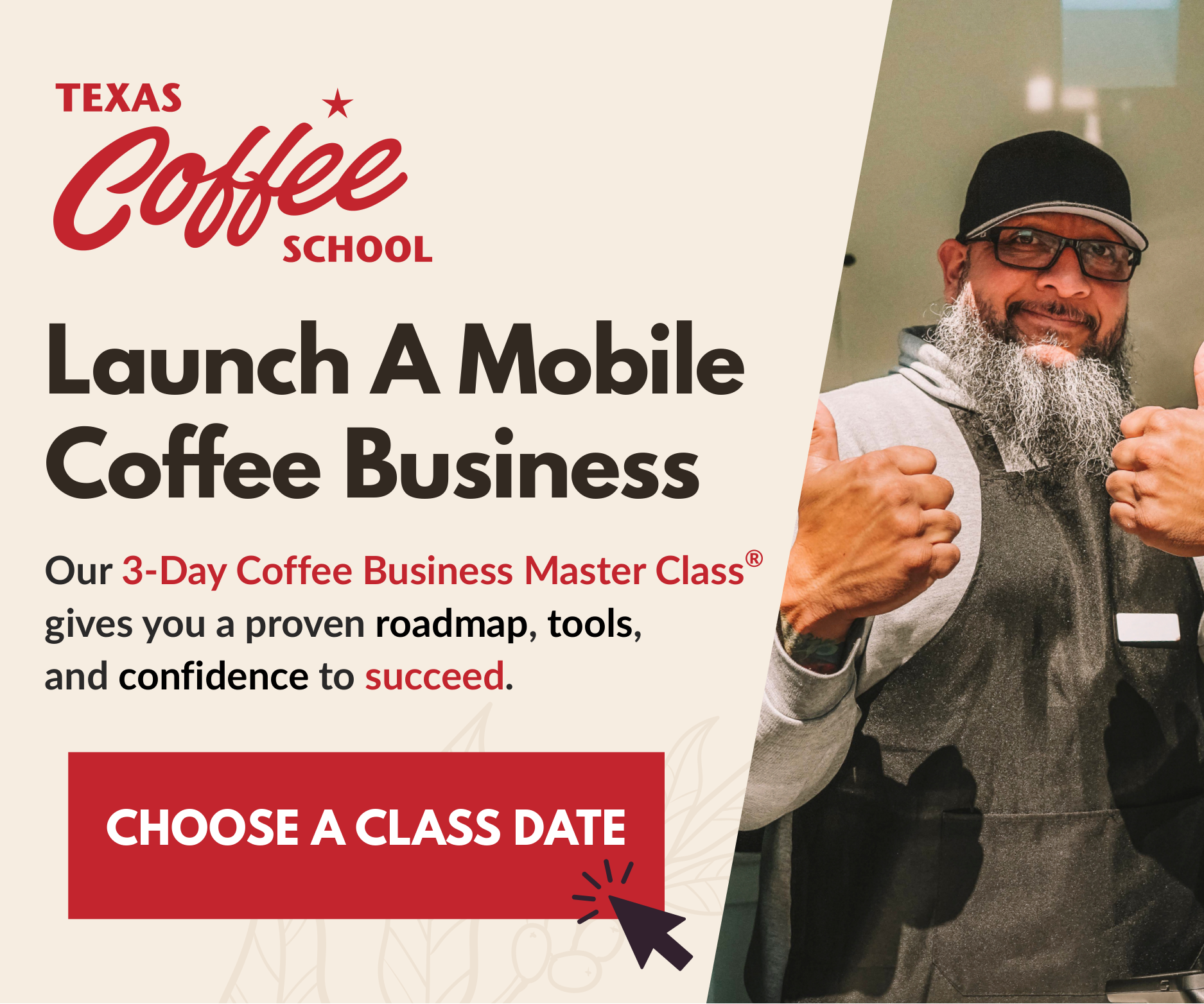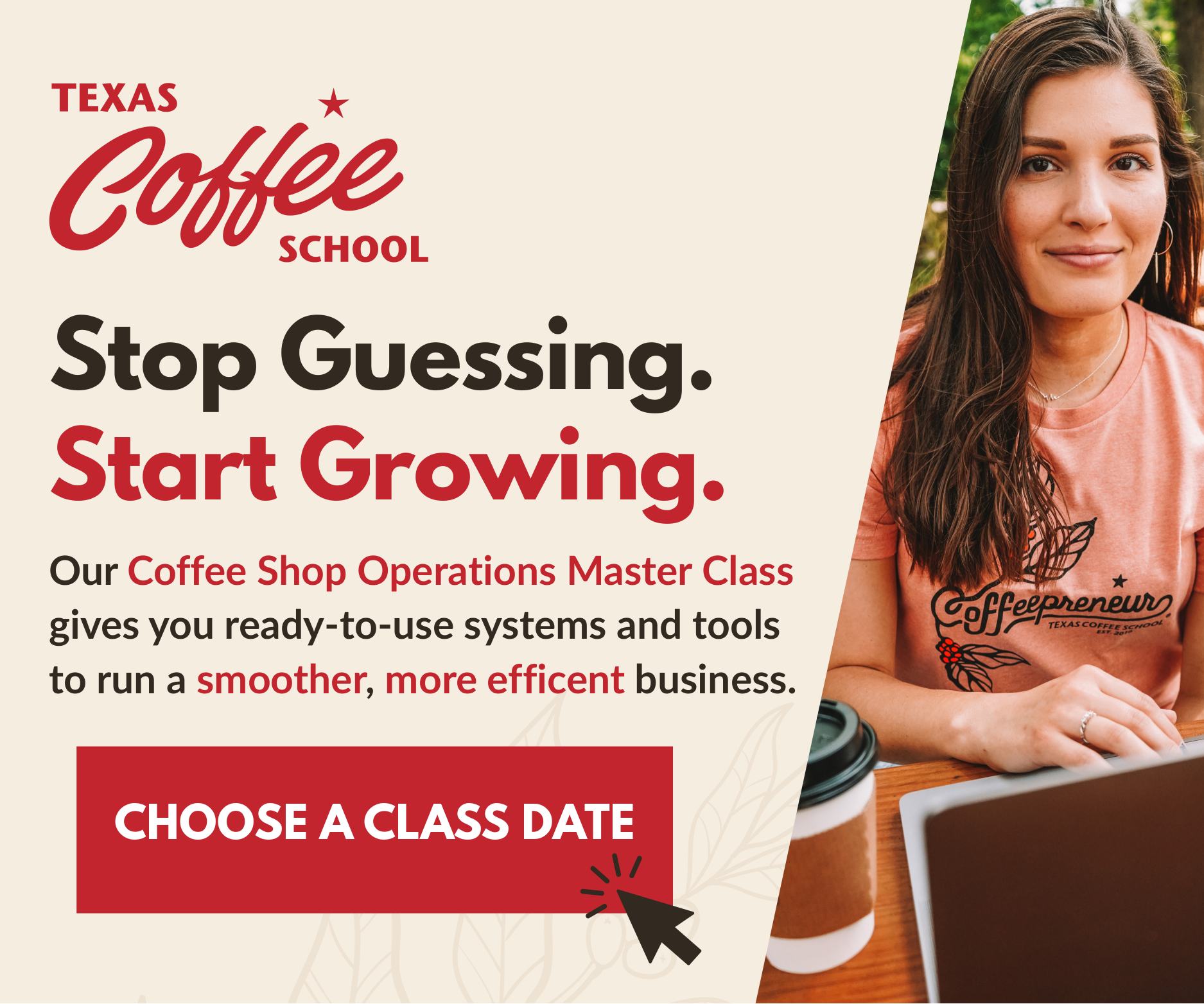This story appears in The Coffee Shop Handbook, Fresh Cup’s print resource for coffee shop leaders—get your copy here.
Many coffee shops sell the same core sets of products, follow the same operational principles, and provide very similar customer experiences. It’s no surprise, then, that many also fall into the trap of repeating the same marketing strategies and cliches. Think of overused refrains like “roasted to perfection,” “life’s too short for bad coffee,” or “make coffee better.” These lines, and others like them, are so common that they are effectively meaningless.
But coffee shops aren’t monolithic. Your business is full of character and purpose that are unique to you, even if your menu is similar to the cafe’s down the street. When your marketing strategy and messaging reflect that distinct personality, customers will notice.
I have spent years working as a marketing consultant for coffee businesses and food and beverage companies around the world. I’ve helped organizations ranging from single-location coffee shops to global equipment manufacturers clarify their brand messaging and marketing strategies.
And I’ve come to the following conclusion: Typical marketing frameworks and advice don’t serve coffee companies, but rather produce a sea of sameness. We in the coffee world need our own marketing framework—one that meets our industry’s unique perspectives and challenges.
The Coffee Marketing Pyramid
Twentieth-century psychologist Abraham Maslow is famous for formulating the Hierarchy of Needs, a framework for understanding what people need to feel productive, healthy, and fulfilled. To reach the highest levels of satisfaction (self-belonging), a person must start at the very bottom of the pyramid, where physiological needs are met (shelter, food, and water). According to Maslow, it’s not possible to skip stages of the hierarchy. You must meet your most foundational needs before you can move up the pyramid.
Marketing works the same way. Take the right steps, and you can travel up the pyramid to build a holistic marketing platform that ensures long-term business success. Skip out on building your foundation, and you’ll find yourself with an unstable strategy, burning cash on marketing efforts that produce seemingly zero results.
Here’s how I break down the Coffee Marketing Pyramid when I coach business owners:
- Level 1: Brand Essence
- Level 2: Brand Messaging
- Level 3: Marketing Strategy
I’ve seen many first-time founders try out individual marketing tactics without building the pyramid. They might set up shop and immediately run Facebook ads announcing their grand opening, for example, or design a loyalty program without considering why their customers would even want to be loyal.
There’s a reason individual marketing tactics like these do not get their own level of the pyramid—they should result from your strategy, not exist outside of it.
A few years ago, I reached out to a couple dozen business owners and asked about their experiences with paid advertising. Nearly all of them felt it had been a colossal waste of resources. I began collecting a file of Facebook ads from coffee companies to better understand why they were ineffective—and quickly discovered that ~90% of them recycled the same cliches. Very few ads contained any meaningful differentiation, personality, or brand story. Instead, they were full of the following phrases:
Coffee Marketing Cliches to Avoid
Roasted to perfection Brewed to perfection Never run out of coffee again Life’s too short for bad coffee We travel the world to find the best coffee beans Our coffee is so good, it speaks for itself Just good coffee Make coffee better Only the best coffees Delivered to your door Fuel your day Your daily dose of joy
Consumers can easily tell when a brand’s marketing is too similar to what they’ve seen before. In their eyes, it signals that your business doesn’t offer anything new, unique, or special. That’s even more true in the age of artificial intelligence writing, when generic marketing copy can be produced on larger scales.
There’s no way around it: Finding a unique and effective marketing strategy starts by building the pyramid. Here’s how.
Level 1: Brand Essence
What are you even doing here?
First, you need to know: Why are you starting your coffee business? What was the ‘aha moment’ that inspired you? What’s the deep-seated passion or mission you’re on? This is the intangible spark, the essence of why you exist. Your marketing messaging, strategy, and tactics all flow from this point.
When you can’t identify that compelling why, you can’t turn it into powerful messaging that resonates with your customers. And that’s how we end up with a sea of interchangeable coffee websites, Facebook ads, and social media pages.
If you’re having trouble articulating your why, below is a set of questions I use when interviewing coffee founders:
Who are you fighting for?
Pick a person or group to be a passionate advocate for. Customers connect with businesses they feel are engineered to meet their needs, whether they’re a super-enthusiast looking for high-end coffee or a parent coffee lover who wants a kid-friendly way to get out of the house. Be specific about who will feel the most at home in your space.
What are you fighting against?
Combatting a common enemy builds bonds between you and your people, and puts you on a mission together. The enemy can be an emotional one, like greedy corporations or overserious brands. Or it can be tangible, like poverty in your local community or the lack of access to healthcare in developing areas of the world.
When you put these two positions together, you have 1) A person you can passionately relate to, and 2) A common enemy you can fight together. That’s how connections are made and loyalty is earned. Those who stand for nothing gain nothing.
If you’re still struggling to identify your core values, but you’re already in business, take 15 customers who you think will give honest feedback, and ask them what your values are. They’ve been around your business for months, or possibly years—they’ll have absorbed what’s important to you over time. Ask them to describe your values in clear language, and then listen to them.
Level 2: Brand Messaging
How do you show up?
Think of your brand essence as Play-Doh. It’s your core building material, but it starts out as formless and meaningless to everyone but you. You must begin shaping it into something recognizable and relatable for it to work. This is the process of determining your brand messaging—and in my experience, it’s the most challenging and least understood level of the Coffee Marketing Pyramid.
I’ve heard founders share the following response many times: “We know what we stand for, can’t we just experiment with some ads now?” You can, and you might get lucky. But unless you’re an unusually crafty wordsmith, it’s difficult for most business owners to turn their passion into marketing language without deliberately sitting down and creating that language. After all, it’s not enough to have a strong brand essence—your customers have to be able to understand and relate to it.
I recommend creating a brand messaging guide for your coffee business. Think of it like a visual branding guide, except instead of your logo and colors, it features your core marketing messages. This is a living document that captures your brand essence, story, and values and transforms them into something actionable. Whenever you start writing for your website, drafting e-commerce emails, or creating social media posts, you can pull it up and quickly re-align with your brand messaging.
Here’s what I like to include when creating these guides with consulting clients:
Brand Promise
Mission and vision statements are often fluffy, generic, and unhelpful. I prefer to coach new founders to use a promise to capture who they are and what they want to accomplish. A promise contains action and an outcome. A promise positions how you show up for your staff and customers. Yours might look something like this:
We promise…
- to push the limits of quality coffee and innovative coffee experiences
- to be on a first-name basis with our customers
- to ethically source coffee, with the receipts to prove it
- to create a space that welcomes and affirms everyone
Your brand promise should be the tangible outcome of your brand essence: who you are fighting for, and what you are fighting against.
Core Values
Identify the causes you’re passionate about, the injustices you’re fighting against, or the areas where you’ll never compromise, and write them down—three to five core values is a good number. To avoid vague, single-word values—like ‘inclusivity’ or ‘quality’—aim for slightly longer phrases, then add a short sentence for additional context. For example:
- Everybody’s somebody: We get to know our customers by name.
- A smile with every cup: Patience and relationships over transactions.
- Brilliant baristas: We cultivate skilled and knowledgeable artisans.
This way of writing forces you to add color and depth to your values. When you use them to train new team members, they’ll offer much more meaning and direction.
Brand Narrative
Build a story around why you launched your company or your big mission. Keep it as concise as possible—just two or three paragraphs—so that it’s a quick read that can also be translated for different marketing mediums. Like any good story, your brand narrative should contain the spark or inspiration that launched this business journey, the thing you are fighting against, and how your business is evolving to overcome it.
First Impressions
How should first-time visitors feel about coming to your shop? Should they be impressed at the sophisticated design and menu? Feel right at home when someone greets them as soon as they walk in the door? Write down those feelings and emotions.
Tone and Voice
Identify a few adjectives that describe how you should sound to visitors, then contrast them with adjectives you don’t want to describe you. Bonus points if you can write a single sentence as an example of each:
We Are Example We Are Not Example Approachable Need help finding the right coffee? We’re here to help! Detached Can’t find what you’re looking for? Contact us. Lighthearted Wow, it’s hot out there! Good thing we know a delish cold brew spot 😎 Serious The perfect fix to today’s heat is a refreshing glass of cold brew. Grateful Your generous support is more meaningful than you know. We’re thrilled to be serving coffee again 🙏 Down-to-biz Thank you for your patience while we were closed down. We’re back and ready to serve more coffee. Savvy Our team is trained and well-equipped to satisfy all levels of coffee lovers. Elitist Our baristas undergo rigorous training to enhance technical skills.
So you have a document full of words. Now what?
This guide isn’t just for internal use. You’ve written out the exact marketing language you can use in social media captions, website copy, emails, and beyond. That means you never have to start from scratch when creating a marketing message again—instead, draw inspiration from this document to infuse your mission, values, and story into everything you do.
And remember: By taking these steps, you’re already in better shape than 95% of coffee businesses.
Level 3: Marketing Strategy
How do you take up space?
A generic marketing strategy is like a lukewarm coffee: disappointing and quickly forgotten. Making your strategy unique requires focused efforts that acknowledge the challenges you face, find ways to overcome them, and define precise action steps that help.
I suggest developing your strategy using the following six steps:
- Identify the current context and challenges you face in building brand equity and gaining new customers.
- Find the white space: a community that’s underserved, a brand vibe that doesn’t exist, or a style of service that’s not well-executed yet.
- Uncover your unique advantage, drawing on your brand essence and messaging. What do you believe, and what can you do that others will not?
- Define precise action steps that use your unique advantage to enter the white space.
- Rate each action step by impact potential, cost, and time to value (aka, ability and speed to execute).
- Prioritize the action steps with the highest impact potential, lowest cost, and fastest time to value.
Let’s look at an example.
The Context
Your coffee shop is operating in an area where customers have many options, but the atmosphere in competing shops tends to be stiff and serious. You want to be known for quality, but don’t want to blend in with the rest of the shops around you.
The White Space
This scenario presents a unique opportunity to differentiate your brand by creating a more relaxed, friendly, and even goofy vibe. Your overarching strategy should aim to transform the coffee shop experience from serious to welcoming, emphasizing the enjoyment and appreciation of specialty coffee in a laid-back setting. Since your market may equate seriousness with quality coffee, you’ll still need to focus on your commitment to quality in marketing.
Your Unique Advantage
Let’s imagine that the initial spark that brought you on this business journey was the cozy vibes ’90s and early 2000s coffee spaces. You’re inspired to create a space for art, culture, and conversation—not a sea of laptops. Your brand promise is coffee that makes friends, friends that make coffee. You’re fighting for the coffee lover who wants to feel at home while they enjoy quality drinks. You’re fighting against the feeling that visiting a serious cafe is a performance where you can’t fully be yourself. With these beliefs and values, you can do things in your business operation and marketing that more serious-seeming competitors won’t. That’s your unique advantage—lean into it.
Specific Marketing Actions
Comforting atmosphere: Design your space to feel less formal and more warm. Add couches, homey lamps, and accessible decor. Choose music and art that feel more casual and communal, rather than cool or serious. Have a board game or Little Free Library corner.
Staff vibes: Train for warmth and friendliness. Instruct baristas to greet and make eye contact with all guests as they enter. Always ask customers their names. Praise emotional intelligence as much as coffee intelligence.
Community openness: Host weekly casual coffee tastings (not stuffy, quiet cuppings). Promote barista-favorite businesses on social media as genuine personal recommendations. Join forces with other local businesses for cross-collaborative products and popups.
Coffee excitement: Write energetic coffee descriptions that capture your excitement for quality, and train baristas how to talk about them. Promote single-origin coffees in-store and online to demonstrate that the warm personality of your brand does not come at the expense of quality.
That’s It—Now, Keep It Going
No matter how you develop your marketing strategy (or any strategy, for that matter), remember this: Good strategy acknowledges where you are now, envisions where you want to go, and draws a clear line through the action steps you need to cross that gap.
In an industry like coffee, where products and experiences can seem similar on the surface, leaning into your brand’s depth and authenticity is often the mechanism—the magic—that unlocks exceptional strategy and memorable marketing.
By taking the time to build your Coffee Marketing Pyramid, you’re not just improving your marketing efforts. You’re clarifying your purpose, refining your voice, and ultimately creating a business that shows up in a meaningful way for your customers and community.
And for the love of all that’s caffeinated, don’t let your customers catch you using “roasted to perfection” or “life’s too short for bad coffee” ever again.
















